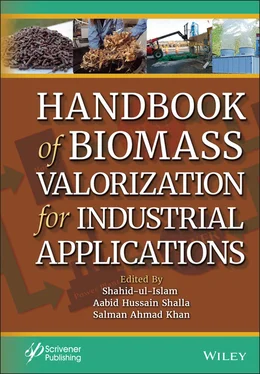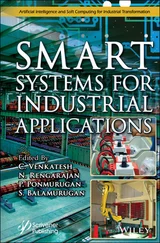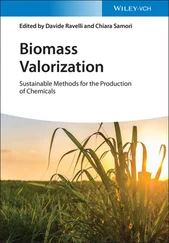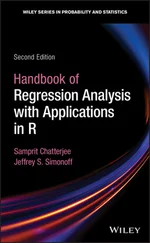Handbook of Biomass Valorization for Industrial Applications
Здесь есть возможность читать онлайн «Handbook of Biomass Valorization for Industrial Applications» — ознакомительный отрывок электронной книги совершенно бесплатно, а после прочтения отрывка купить полную версию. В некоторых случаях можно слушать аудио, скачать через торрент в формате fb2 и присутствует краткое содержание. Жанр: unrecognised, на английском языке. Описание произведения, (предисловие) а так же отзывы посетителей доступны на портале библиотеки ЛибКат.
- Название:Handbook of Biomass Valorization for Industrial Applications
- Автор:
- Жанр:
- Год:неизвестен
- ISBN:нет данных
- Рейтинг книги:4 / 5. Голосов: 1
-
Избранное:Добавить в избранное
- Отзывы:
-
Ваша оценка:
- 80
- 1
- 2
- 3
- 4
- 5
Handbook of Biomass Valorization for Industrial Applications: краткое содержание, описание и аннотация
Предлагаем к чтению аннотацию, описание, краткое содержание или предисловие (зависит от того, что написал сам автор книги «Handbook of Biomass Valorization for Industrial Applications»). Если вы не нашли необходимую информацию о книге — напишите в комментариях, мы постараемся отыскать её.
BIOMASS VALORIZATION
INDUSTRIAL APPLICATIONS
The handbook provides a comprehensive view of cutting-edge research on biomass valorization, from advanced fabrication methodologies through useful derived materials, to current and potential application sectors.
Audience Handbook of Biomass Valorization for Industrial Applications
Handbook of Biomass Valorization for Industrial Applications — читать онлайн ознакомительный отрывок
Ниже представлен текст книги, разбитый по страницам. Система сохранения места последней прочитанной страницы, позволяет с удобством читать онлайн бесплатно книгу «Handbook of Biomass Valorization for Industrial Applications», без необходимости каждый раз заново искать на чём Вы остановились. Поставьте закладку, и сможете в любой момент перейти на страницу, на которой закончили чтение.
Интервал:
Закладка:
2.3.1.2.3 Acid
Acid requires the application of distilled and dissolved acids in order to crack the lignocellulosic material’s rigid shape. Dilute sulfuric acid employed for acid pre-treatment of biomass such as maize, softwood [72]. This will be used to eliminate hemicellulose after alkali pre-treatment (lignin exclusion) results in comparatively pure cellulose, is the most commonly used acid. The benefit of acid pre-treatment is that there is often no need for a corresponding enzymatic hydrolysis step. This may be due to the fact that acid itself hydrolyses the biomass to generate fermentable sugars. Hemicellulose and lignin are solubilized with restricted degradation [74, 75].
2.3.1.3 Physicochemical Pre-Treatment
Steam-Explosion pre-treatment is the mainly used pre-treatment choice. This technique needs both chemical and physical strategies to crack the surface of lignocellulosic substances. This method of volcanic pre-treatment exposes the substance to elevated pressures and temperatures for a brief period of time, after which it gradually depressurizes the system, destroying fibril framework. The degradation of fibrils through hydrolysis enhances the reachability of cellulose to the enzymes. Particle dimension is an important take-parting aspect to the performance of the method. In addition to this, comparatively huge particle sizes found to be capable of producing optimum concentrations of sugar. This is a good finding, since the lowering of the particle sizes needs more mechanical sorting of the raw material. Temperatures between 190 and 270 °C were applied with time intervals of 10 and 1 min, correspondingly. The determining factor for the temperature/time relationship [76, 77] will be the preparatory material and particle sizes.
2.3.1.4 Biological Treatment
The make use of microbes to dissolve lignin and hemicellulose requires biological pre-treatment however keeps the cellulose in unbroken condition [78–80]. Destruction of lignin happens by the action of fungi-secreted enzymes that destroy lignin. While biological pre-treatments entail mild atmosphere and are inexpensive, drawbacks compared to other technologies are slow hydrolysis and inneed of time-consuming pre-treatments [81]. Present efforts in biological pre-treatment include the integration of this method with other pre-treatment techniques and the creation of innovative rapid hydrolysis of microbes [78, 79, 82]. In contrast with chemical & physicochemical pre-treatment methods, all physical and biological processes are not competitive.
Biological method of turning bagasse into required energy is dependent on ethanol-producing fermentation and gas-producing anerobic digestion [83, 84]. To allow cellulose more accessible to hydrolysis and fermentation, this pre-treatment is often employed in conjunction by means of chemical treatment. Biomass can be partly degraded by numerous microorganisms [85]. Furthermore, fungal depolymerization may be done by means of lignin as a biocatalytic [73, 86]. For the breakdown of biomass materials, physical & chemical pre-treatment procedures can be employed. Physical pre-treatment refers to the reduction by mechanical steps of the size of the raw material to make it available to subsequent (biochemical) treatment.
The key process used to crack biomass is dependent on hydrolysis technique. Occasionally, this approach is saccharification. This is utilized to split hydrogen bonds in the fractions of lignocellulosic biomass by extracting. It is resulting hemicellulose with improvements in composition of the cellulose microfiles and retrieving the resultant soluble monomeric and oligomeric sugars [87, 88]. The objective of pre-treatment is to get better usable surface areas, to recrystallize cellulose and to eliminate the substance of hemicellulose and lignin.
2.3.2 Lignin as Bio-Aromatics
By pulping process, the paper manufacturing industries produce about fifty million tons of lignocellulosic biomass. Cracker states that pulping typically extracts lignin from wood pulp to leave only cellulose for paper processing. Just 2% of the remaining lignin, however, is processed into useful materials, with the remainder being burned or going to landfill as low-grade fuels. A breakthrough in the heterogeneous catalytic oxidative depolymerization of lignin using gold nanoparticles aided by lithium aluminum layered double hydrolysis has been documented by Crocke’s team. The group obtained aromatic monomers such as vanillin, vanillic acid and syringaldehyde of low molecular weight by targeting rich β-O-4 linkage within lignin. In the food and fragrance industry, these monomers are usually used [89].
Opportunities for development of lignocellulose to bio-aromatics
New environmental innovations (towards bioeconomy)
Reduction of manufacturing process transportation footprint
Chemicals and materials innovation (safer, performance-based products and through disruptive enabling process technologies)
The transition to bioeconomy is driven by economics and culture.
For lignin-based goods, physicochemical variables promise a future.
Presence of rings of aromas (stability, good mechanical properties)
Strong viscoelastic and rheological properties
Strong capability for film-forming
Compatibility for a broad variety of synthetic chemical goods
The scale of small objects.
2.4 Lignin as Future Building Block
Lignin is a part of wood that has proven to be an especially promising resource. Currently, it is used almost solely for electricity storage, but it may be used for many other applications as well. Lignocellulose provides structure and stability to plants (Latin lignum = wood). The cell wall of plants is reinforced by lignocellulose biopolymers and consists of their key constituents: cellulose and hemicellulose from structure through lignin is inserted as a form of connector. Resistance to wind and pests by cell wall lignification producer plants. In comparison to fossil petroleum, wood-based lignocellulose, straw is a green raw material that can be cultivated in fields and woods and is climate-neutral. In comparison, the quantity of CO 2emitted into the atmosphere is by firing wood and woody materials.
To manufacture the products such as synthetic fibers, fertilizers, etc., the chemical industry depends entirely on carbon components. In Germany, nearly 80% of the carbon composites employed for these reasons are gasoline, natural gas and coal. Carbon, however, also appears in plants. During photosynthesis, the plant binds carbon dioxide to the atmosphere and uses it to create molecules rich in energy, mostly sugar compounds. To a small degree, 13% of the chemical industry now uses green materials, primarily vegetable oil, starch, natural rubber and cellulose. The long-standing plan is to establish biorefineries using which recycled materials can be utilized in them completely in an integrated supply series to raise this percentage of us in the future. The key fields of research are the farming of raw materials via collection & distribution of plants manufacturing lignocellulose, analyzing of new extraction methods, and various synthesis techniques which are used to produce biodiesel and related materials.
Lignin that comprises 30% of the lignocellulose biomass is an untapped treasure. It consisting of various aromatic building blocks which are very helpful. Aromatic complexes are usually produced from petroleum and are useful to make plastic medications and tints. Therefore, lignin’s abilities are incredibly more; lignin, in addition to chitin, is the mainly plentiful polymer and containing a significant number of aromatic mixtures.
Lignin has tremendous potential for applications. The amount of lignin utilized in the chemical industry in the upcoming years, however, varies on several parameters; on the other hand, it varies on the advance in crude oil values. For future growth of a biobased economy, lignocellulose will become an essential feedstock, while upto 75% of dry weight of lignin consists of sugar, occurs in a polymerized condition [89].
Читать дальшеИнтервал:
Закладка:
Похожие книги на «Handbook of Biomass Valorization for Industrial Applications»
Представляем Вашему вниманию похожие книги на «Handbook of Biomass Valorization for Industrial Applications» списком для выбора. Мы отобрали схожую по названию и смыслу литературу в надежде предоставить читателям больше вариантов отыскать новые, интересные, ещё непрочитанные произведения.
Обсуждение, отзывы о книге «Handbook of Biomass Valorization for Industrial Applications» и просто собственные мнения читателей. Оставьте ваши комментарии, напишите, что Вы думаете о произведении, его смысле или главных героях. Укажите что конкретно понравилось, а что нет, и почему Вы так считаете.












